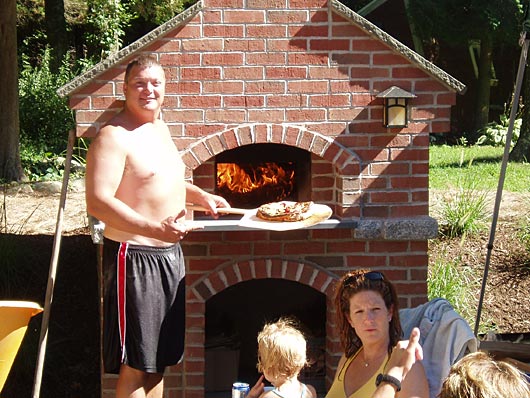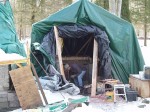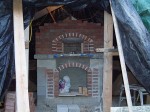Building in winter in a tent
Hello Rado,
the oven is cooking great, thanks again for all the help and for your building workshops on DVD.
Here are some photos of the finish oven and also from the building progress. We actually built the oven in the winter inside a provisional tent. All of us we truly enjoy it.
I got your wood burning pizza-bread-roast-pot brick oven building workshops on CD’s from eBay a while back. We fired it already many times for cooking just about everything we eat or what our family members plus friends eat. This oven performs beautifully well and it is very efficient indeed and everybody regards my work on it highly enough.




Paul
from Killingworth, CT
Respond to the Building in winter in a tent article:
2 Comments
Sorry, the comment form is closed at this time.
I’d like to build a pizza oven into my kitchen. There is a now unused cinder block chimney that goes through the space that I would like to take advantage of. Is there any reason I could not do that? If not where can I find plans to build a small indoor oven? Thanks a bunch.
added by Rado:
Hi Tim,
Do you live in cold climate? If I lived in freezing or cold location I would definitively build/have one oven indoors.
You can get used to your oven when it’s smaller inside. It is easy to change the oven size internally, just by adding in or taking off a brick or two from a side. All remaining matters stay the same. Indoor you use less material, minus the outer walls, roof, etc. I can send you several images of one such oven, it was built in it’s simplest form with no decorations on it. It will give you all ideas. One thing to consider; the oven is heavier so the floor on which it sits should be stronger or supported under.
I would have to see your cinder block chimney, hard to say with no further information of how or where exactly it is constructed. What is on the outside of the chimney blocks? – cross section – what are the internal measurements of the chimney and how tall is it all up? What is or what was its purpose?
With compliments.
By Tim
Hey Rado, don’t ship disks, I’d rather get a download. As previously mentioned I am putting an oven in my kitchen in the northeast. Let me know which design would adapt best.
Thanks for the fast response. Yes, I am in the northeast of the US and we’d love to have a wood fired oven in our kitchen/dining area for the cold winter months. Cool to know that I could modify your design to fit my space. Here’s what I can tell you about it: I looked at it again today and what I have is a basement to roof conventional brick chimney that has been mudded on the outside. It was formerly used for an oil-fired furnace that has been replaced with hi-efficiency propane, so the chimney is unused. It is 24″x24″ and has a 6″x8″ ceramic liner that is clean top to bottom with no discernible cracks. It goes through the center of the house so it only gets outside above the roof line, where it is finished with stone. Once I cut into it I believe I can build on top of the unused chimney below for support, but could also carry the extra load to nearby framing structure. The location in my kitchen where I had wanted to put it is currently boxed in with wood framing and is 31″x27″. I’d like the oven to stay close to those dimensions as traffic flow will be impeded if it gets much bigger. It can be seen on the far left of the enclosed photo.
Thanks,
Tim
added by Rado:
Look at the 3G MTo design sequence; insulation under top slab and firebrick hearth, IF your indoors oven performs efficiently and well you will be a winner. In my email with download links attached 1 pdf which contains how the firebricks go, how many are used in the design as is original – they are your size 2-1/2″ – 64mm bricks thickness. The chimney you described looks to have proper draft conditions (even if there is a real good draft, still make the flue-hood spacious as it is in all my designs – notice it is not only wide, but also deep – it’s the area in front just outside the oven. When the flue is of this size 100% all fumes will be caught and dragged into the hot air passage out through the chimney. That’s especially important in indoors ovens.)
By Tim